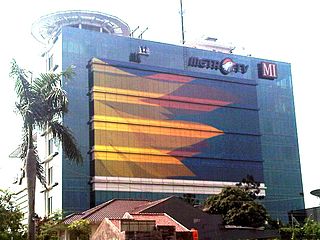Commercial broadcasting is the broadcasting of television programs and radio programming by privately owned corporate media, as opposed to state sponsorship. It was the United States′ first model of radio during the 1920s, in contrast with the public television model in Europe during the 1930s, 1940s and 1950s, which prevailed worldwide, except in the United States and Brazil, until the 1980s.

RCTI is an Indonesian free-to-air television network based in West Jakarta. Its programming consists of news bulletins, sports events and soap operas.

Surya Citra TV (SCTV) is an Indonesian free-to-air television network. It was launched on 24 August 1990 in Surabaya, East Java as Surabaya Citra Televisi, broadcasting to the city and its surrounding area. At first, the programming was similar to that of RCTI, using some of their news programs until they could produce their own. On 1 August 1993, SCTV obtained a national license and eventually moved its operations to Jakarta, changing its name to Surya Citra Televisi. Its main offices are located in Central Jakarta, with studios in West Jakarta. It is owned by Surya Citra Media, part of the technology company Emtek.

TVRI is a state-owned, public broadcasting television network and the oldest television entity in Indonesia. Its national headquarters is in Gelora, Central Jakarta.
The media of Brunei are strictly controlled by the government under Sultan Hassanal Bolkiah, which has effectively imposed martial law in the country since the Brunei Revolt of 1962. News coverage consists of police-beat reporting, lifestyle features and community events, with little in the way of diverse viewpoints. Reporters Without Borders reports there is "virtually no criticism of the government". The liberal democracy watchdog Freedom House lists Brunei's media as "not free".

Kompas Gramedia is the largest media conglomerate in Indonesia.
Transvision is a subscription-based direct broadcast satellite provider service for Indonesia. It is a joint venture between Telkom Group and Trans Corp Now Transvision is fully owned by joint venture between Telkom Group and Trans Corp.

State-run station TVRI held a television monopoly in Indonesia until 1989, when the first commercial station, RCTI began as a local station and was subsequently granted a national license a year later.

PT MNC Investama Tbk, formerly known as PT Bhakti Investama Tbk, doing business as MNC Corporation or MNC Group, is an Indonesian multinational conglomerate engaged in media, finance, property, natural resources and transportation based in Jakarta, Indonesia. It was established on 2 November 1989 as a financial security company. It holds a majority shareholding of Global Mediacom, MNC Financial Services, and MNC Land.
MNCTV, formerly known as TPI and Televisi Keluarga Indonesia is an Indonesian private television station. MNCTV was established by Tutut Soeharto, the first daughter of former president Soeharto. It began broadcasting on 1 August 1990, at first broadcasting only educational programs, but has since become similar to other Indonesian TV stations, showing programs such as quizzes, sinetron, reality TV shows, sports shows, and recently, dangdut music.
Indonesian terrestrial digital television is the replacement of Indonesian analogue TV and runs in digital video broadcasting terrestrial (DVB-T2).
Bali Post Media Group (BPMG) is an Indonesian media conglomerate founded by Ketut Nadha in 1948. Bali Post Media Group is said to be the largest media holder in Bali, Indonesia. It is currently led by ABG Satria Naradha, the son of Ketut Nadha. It has diversified businesses and interests in media industry. BPMG businesses include broadcast media, print media, online media, and a number of other businesses.

PT Elang Mahkota Teknologi Tbk is an Indonesian technology, telecommunication and media conglomerate and headquartered in Jakarta. As of 2013, it is Indonesia’s second largest media company. It is the parent company for subsidiaries which include terrestrial television subscription NexMedia and three television stations – SCTV, Indosiar and O Channel. It was established in 1983 by Eddy K. Sariaatmadja. Currently, the company is headed by Alvin W. Sariaatmadja as its President Director.

Media Group is an Indonesian media group founded by Surya Paloh. The group owns three newspapers, a tabloid Prioritas, and a television channel MetroTV.
Peter Frans Gontha is an Indonesian businessman, commercial television pioneer, and jazz impresario. He served as Indonesian ambassador to Poland from October 2014 to January 2019.
iNews is an Indonesian free-to-air television network founded by Media Nusantara Citra.
PT Surya Citra Media Tbk (SCM) is an Indonesian mass media company owned by Elang Mahkota Teknologi and is based in Jakarta. It operates four television stations, SCTV, Indosiar and O Channel.











